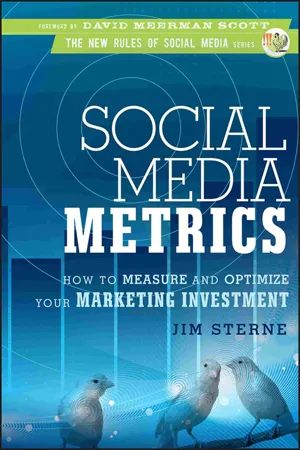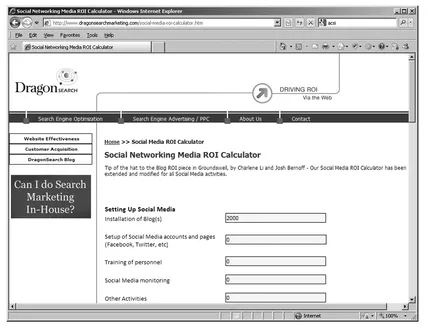![]()
CHAPTER 1
Getting Focused—Identifying Goals
I know the price of success: dedication, hard work, and an unremitting devotion to the things you want to see happen.
—Frank Lloyd Wright
Give me a stock clerk with a goal and I’ll give you a man who will make history. Give me a man with no goals and I’ll give you a stock clerk.
—J.C. Penney
Measuring for measurement’s sake is a fool’s errand. But we’re all fools now and again.
The human mind loves order. People think their iPod really knows how they feel by how it sequences songs just so when set to “shuffle.” People tell fortunes by reading the leaves in the bottom of a tea cup or from the succession of upturned tarot cards. When faced with absolute randomness, the human mind kicks into overdrive to find patterns. We enjoy spending quiet time on the grass finding animals in the clouds, and conspiracy theorists can find plots and schemes in random events.
In the same way, web marketers have attempted to divine significance from the rows of IP addresses, file names, byte counts, and time stamps in the log files of web servers from the very beginning.
Over the years, with the advent of additional data collection technologies, we have proven that our conjectures and prognostications are valuable to business. Hypotheses can be scientifically tested to show that we understand and can influence onsite behavior by making specific changes to a web site and measuring the results. We can alter our prospective customers’ behavior by altering our promotional efforts and persuasion techniques.
Measurement Is No Longer Optional
Katie Delahaye Paine is a PR maven who understands social media better than most. She’s an insightful consultant and an engaging speaker, and one of her more popular PowerPoint presentations is available online at www.themeasurementstandard.com/issues/5-1-09/paine7stepssocial5-1-09.asp. It’s called “7 Steps to Measurable Social Media Success.”
In step two, Katie advocates setting clear, measurable objectives. She says you need to know what problem you need to solve, you need to not do anything in social media if it doesn’t add value, and she reminds us that you can’t manage what you can’t measure—so set measurable goals.
Whether money is tight or times are good, everybody is bent on improving their business performance based on metrics. You cannot continue to fly by the seat of your pants. Automated systems and navigational instrumentation are required on passenger planes, and your business deserves no less.
As the tools escalate in sophistication, there remains one truism that cannot be ignored. Regardless of the amount of data and the cleverness of analytics tools one has, we still need analysis. The sharpest analyst or most talented statistician in the world is stymied without data, to be sure. But without those brilliant minds cogitating about a given purpose, those tools and data can create pretty charts and graphs and not much else. The most frequent missing piece is a specific problem to solve.
Every analyst has been asked to describe the past, explain the present, and tell the future given a data warehouse full of bits and bytes and the assumed ability to interpret human intent.
When faced with the question “Here’s a bunch of data—what does it mean?” there are only two responses. The first is a tedious explanation of how the word “data” is the plural of datum and therefore the inquisitor’s grammar is lacking. This approach is tiresome for the addressee and only fun for the analyst the first couple of times. The second response is “What problem are we solving for?” While this is an equally egregious mangling of the King’s English, it is an integral part of the analytical vernacular.
The question, while sounding just as haughty as the former grammar lesson, is critical. When getting into a taxi, one is expected to know and communicate one’s destination. Of course a statistician can groom a large data dump and find correlations between temperature, elevation, and the rate of change in barometric pressure. But he won’t volunteer the critical answer of whether you should bring an umbrella unless you specifically ask, “Do you think it might rain?”
The same is true of marketing—especially online marketing—where we are data rich and insight poor.
Measurement, Metrics, and Key Performance Indicators
There were 4,231 views and mentions of your viral marketing campaign on the first day.
On hearing this, you might jump out of your chair, run down the hall, high-five the older members of your team, fist-bump the younger ones, and open a bottle of champagne. Alternatively, you might slump in your chair, hide from the rest of your team, and open a bottle of antidepressants.
Four thousand two hundred and thirty-one is a measurement. Without context, it is merely a number. When compared with your personal best, company expectations, or your competitors’ efforts, that number becomes a metric. It is now indicative of value, importance, or a change in results.
If that metric is central to the well-being of the organization, it might be considered a Key Performance Indicator (KPI). It might be worthy of daily e-mail updates, dashboard placement, and iPhone App notifications. To be a KPI, it must indicate how well your organization’s goals are being served. Therein lies the rub—the downfall of web measurement people everywhere: ill-defined objectives.
Without context, your measurements are meaningless.
Without specific business goals, your metrics are meaningless.
Proceed Ye No Further if Ye Have No Goals
It is crucial to map out your specific business goals before embarking on a social media program. As Yogi Berra put it, “If you don’t know where you are going, you will wind up somewhere else.”
Companies that tout their “success” because they track the number of friends and followers will never compete effectively with those who track sales and profits gained from reaching out to their followers. You want a goal? Income’s a great goal—but it’s not alone.
THE BIG THREE BUSINESS GOALS
It’s time to get very high-level. There are only three true business goals (Figure 1.1).
They are all that matters in the long run. If the work you do does not result in an improvement to one or more of these Big Three Goals, then you are wasting your time, wasting money, spinning your wheels, alienating customers, and not helping the organization. You may be covering your backside and building your empire, but in the long run you will not ensure your status as an employee.
Figure 1.1 Your focus should always be on either increasing revenue, lowering costs, or improving customer satisfaction. Doing all three would be just fine.
There are many measurable elements that indicate whether you are improving on one or more of these Big Three Goals. You need to keep an eye on these critical factors because you are running your marketing programs in real time and can’t wait for month-end or quarterly results to make adjustments along the way. “Are we there yet?” is the question asked from the backseat. “Are we still going in the right direction?” and “Is there anything in the way?” are asked from behind the wheel and lead to business and career success.
You can always think of something to earn more, spend less, and make customers happier. If you can do all three atat the same time, do please give me a call. You are headed for greatness, and I love a good case study.
Increased Revenue
Considered the easiest to measure, revenue is always tabulated in terms of cash. You raked it in or you didn’t. You met the expected return on investment or you missed the mark. You brought in more this time than last time or you fell under the bus. A Mark, a Yen, a Buck or a Pound, they are very easy to tot up.
If the things you are measuring cannot be connected back to income, then you need to be very clear why you are taking the time to measure them. You can completely baffle your colleagues with analytics colloquialisms like sentiment volatility rate, pass-along engagement velocity, and uptake-to-captivation ratios. But as soon as you connect the dots to arrive at income, everybody knows what you are talking about and has a standard, consensual means of evaluating the righteousness of your social marketing programs.
While income is always the pot of gold at the end of the rainbow, there is another consideration that cannot be ignored: the other side of the profit equation called Cost.
Lowered Costs
It’s easy to bring in a million dollars; just sell two million one-dollar bills for 50 cents each. Clearly, your attention should be focused on profits. So, while coming up with new and innovative ways to make sales, don’t forget to come up with new and innovative ways to lower expenses. If you can lower the cost of finding that pot of gold, then there’s more net gold to go around.
Customer service and market research are the obvious areas where social media can boost profits by lowering costs, but it’s a fine balance. You must spend money to make money, but if you can show that social media is a less expensive way to measure public opinion, make friends, and influence people, then you can have a larger share of the budget next time around. Oh, and you get to keep your job, too.
Improved Customer Satisfaction
The great thing about improving customer satisfaction is that it raises revenue and lowers cost. Happier customers are more likely to buy again. It is cheaper to sell something to somebody already in your database than it is to have to beat the bushes to find new ones. So if customer satisfaction is a factor in income and expense, and if income and expense are simply part of the profit equation, then the only goal worth worrying about is profits, right? Not so fast, Mr. Lay.
Remember Kenneth Lay? The famous CEO, last seen being walked out of Enron headquarters wearing government-issued bracelets? It seems that when one focuses on profits alone, one steps in over one’s head with unpleasant results.
Happy customers are necessary to the life of a business if you can just force yourself to look beyond the quarterly report. A 6- or 9- or 12-month window will verify that a company with unhappy customers is not on a path to survival. Curiously, there is proof. A company’s American Customer Satisfaction Index score “has been shown to be predictive of both consumer spending and stock market growth, among other important indicators of economic growth” (www.theacsi.org). Yes, that’s right, happier customers make for increased stock prices.
THE FREE CALCULATOR DILEMMA
If you need a down and dirty answer to how much social media can raise revenue and lower costs, there are plenty of online tools like DragonSearch’s Social Networking Media ROI Calculator (Figure 1.2). These calculations are ideal for those who have to fit into a specific budget and wish to manipulate the numbers until they do what they’re told.
Figure 1.2 DragonSearch’s Social Networking Media ROI Calculator lets you fudge the numbers till they’ll play nice. (www.dragonsearchmarketing.com/social-media-roi-calculator.htm)
All spreads...


